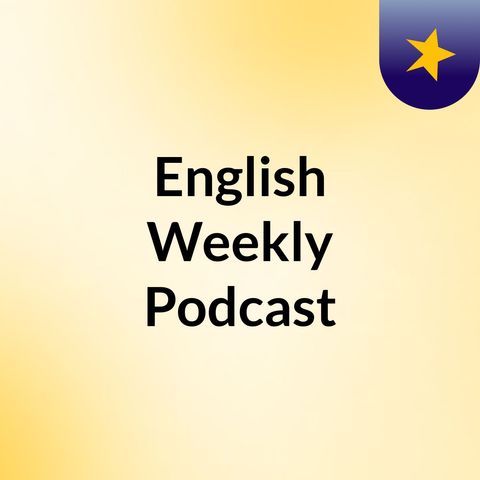
Contacts
Info
Welcome to the WEEK 1 podcast where we'll be exploring some basic English grammar structures.First, let's look at social phrases that you can use in introductions. You can say "Hi,...
show more
Welcome to the WEEK 1 podcast where we'll be exploring some basic English grammar structures.First, let's look at social phrases that you can use in introductions. You can say "Hi, my name is..." or "Nice to meet you" when greeting someone.
When introducing yourself, be sure to use the verb "to be" in the simple present tense. For example, "I am a student."
Personal pronouns such as "I", "you", "he", "she", and "they" are used to refer to people or things.
To show possession, we use possessive adjectives such as "my", "your", "his", "her", and "their". For example, "This is my book."
Demonstrative pronouns like "this" and "that" are used to point out specific things. For instance, "This is my pen."
Question words such as "what", "where", "when", "why" and "how" are vital when seeking information. For example, "What is your name?"
Numbers are also essential when communicating, and it's good to learn numbers from 1 to 10.
When referring to places, we use "there" and "here". For example, "The pen is there" or "I am here".
Lastly, some useful language you can use in conversations includes "Excuse me", "Could you please", and "Thank you".
That's it for this podcast. Thank you for listening, and I hope this information is useful to you!
show less
When introducing yourself, be sure to use the verb "to be" in the simple present tense. For example, "I am a student."
Personal pronouns such as "I", "you", "he", "she", and "they" are used to refer to people or things.
To show possession, we use possessive adjectives such as "my", "your", "his", "her", and "their". For example, "This is my book."
Demonstrative pronouns like "this" and "that" are used to point out specific things. For instance, "This is my pen."
Question words such as "what", "where", "when", "why" and "how" are vital when seeking information. For example, "What is your name?"
Numbers are also essential when communicating, and it's good to learn numbers from 1 to 10.
When referring to places, we use "there" and "here". For example, "The pen is there" or "I am here".
Lastly, some useful language you can use in conversations includes "Excuse me", "Could you please", and "Thank you".
That's it for this podcast. Thank you for listening, and I hope this information is useful to you!

Transcribed
11 MAR 2024 · Discover the Modal Verbs of Prohibition, Advice and Obligation with some useful tips to improve your English language 😁
Music from #Uppbeat (free for Creators!):
https://uppbeat.io/t/andrey-rossi/bring-the-fun
License code: TG5PRTUDHNRHFCCV
Transcribed
4 MAR 2024
10 OCT 2023
10 OCT 2023
10 OCT 2023
Welcome to the WEEK 1 podcast where we'll be exploring some basic English grammar structures.First, let's look at social phrases that you can use in introductions. You can say "Hi,...
show more
Welcome to the WEEK 1 podcast where we'll be exploring some basic English grammar structures.First, let's look at social phrases that you can use in introductions. You can say "Hi, my name is..." or "Nice to meet you" when greeting someone.
When introducing yourself, be sure to use the verb "to be" in the simple present tense. For example, "I am a student."
Personal pronouns such as "I", "you", "he", "she", and "they" are used to refer to people or things.
To show possession, we use possessive adjectives such as "my", "your", "his", "her", and "their". For example, "This is my book."
Demonstrative pronouns like "this" and "that" are used to point out specific things. For instance, "This is my pen."
Question words such as "what", "where", "when", "why" and "how" are vital when seeking information. For example, "What is your name?"
Numbers are also essential when communicating, and it's good to learn numbers from 1 to 10.
When referring to places, we use "there" and "here". For example, "The pen is there" or "I am here".
Lastly, some useful language you can use in conversations includes "Excuse me", "Could you please", and "Thank you".
That's it for this podcast. Thank you for listening, and I hope this information is useful to you!
show less
When introducing yourself, be sure to use the verb "to be" in the simple present tense. For example, "I am a student."
Personal pronouns such as "I", "you", "he", "she", and "they" are used to refer to people or things.
To show possession, we use possessive adjectives such as "my", "your", "his", "her", and "their". For example, "This is my book."
Demonstrative pronouns like "this" and "that" are used to point out specific things. For instance, "This is my pen."
Question words such as "what", "where", "when", "why" and "how" are vital when seeking information. For example, "What is your name?"
Numbers are also essential when communicating, and it's good to learn numbers from 1 to 10.
When referring to places, we use "there" and "here". For example, "The pen is there" or "I am here".
Lastly, some useful language you can use in conversations includes "Excuse me", "Could you please", and "Thank you".
That's it for this podcast. Thank you for listening, and I hope this information is useful to you!
Information
| Author | Leonor Adelina Gamboa |
| Organization | Leonor Adelina Gamboa |
| Categories | Language Learning , Language Learning , How To |
| Website | - |
| cuttiebiscuit@gmail.com |
Copyright 2024 - Spreaker Inc. an iHeartMedia Company
